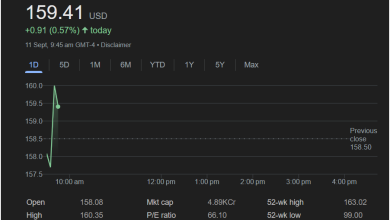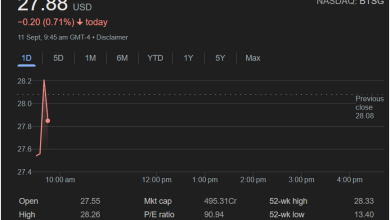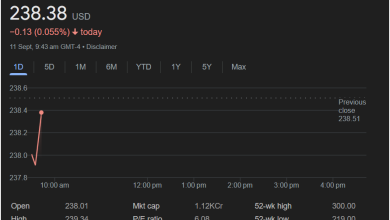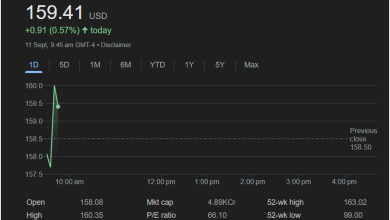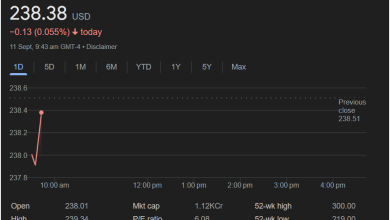Goldman Sachs (GS) Stock Soars 3.65%, Eyes 52-Week High Amidst Roaring Investor Confidence
The financial behemoth's shares posted one of their strongest single-day gains of the year, closing at $741.89 as positive market sentiment and heavy trading volume propelled the stock upward

(NEW YORK, NY) – Shares of The Goldman Sachs Group, Inc. (NYSE: GS) experienced a significant rally in yesterday’s trading session, closing with a robust gain of 3.65%. The investment banking giant’s stock finished the day at
26.14 from its previous close, signaling a wave of bullish sentiment sweeping through the financial sector.
The trading session on August 22nd was characterized by sustained upward momentum from the opening bell. The stock’s powerful performance brought it tantalizingly close to its 52-week high of $749.05, a key psychological and technical level that investors are now watching closely. The strong finish, coupled with a slight additional gain in after-hours trading, has positioned Goldman Sachs as a standout performer in a market showing renewed vigor.
This surge is not just a number on a chart; it reflects a deeper confidence in the firm’s strategic positioning and the health of the broader economy. For investors, this decisive move marks a potential breakout, capping a period of consolidation and pointing towards a positive outlook for one of Wall Street’s most storied institutions. This article will delve into the specifics of the day’s trading, explore the potential catalysts behind the rally, and analyze what this means for investors and the market at large.
A Detailed Look at the Day’s Trading Action
To understand the significance of the rally, it’s crucial to examine the intraday trading dynamics. Goldman Sachs’ stock demonstrated strength from the very beginning of the session.
-
Opening Price: The stock opened at $720.14, already gapping up significantly from the previous day’s close of $715.75. This strong open immediately indicated high buyer interest.
-
Intraday Low: The day’s low was recorded early in the session at $718.58. Importantly, this low was still comfortably above the previous day’s close, a classic sign of a bullish trend where buyers step in on even minor dips.
-
Intraday High and Closing Momentum: The stock climbed steadily throughout the morning, breaking through several resistance levels. It reached a daily peak of
741.89, near the top of its daily range. This type of closing pattern is often interpreted by analysts as a sign of institutional accumulation and strong conviction among buyers.
-
After-Hours Activity: The positive momentum carried over into the extended session, with the stock ticking up an additional
742.40**, suggesting that investor appetite remained strong even after the official close.
The journey from a low of $718.58 to a high of $744.84 represents a daily trading range of over $26, highlighting the volatility and immense buying pressure that characterized the session.
Potential Catalysts: Why Did Goldman Sachs Stock Rally?
A move of this magnitude is rarely caused by a single factor. Yesterday’s surge was likely the result of a confluence of positive macro-economic tailwinds and sector-specific optimism. While no single company-specific news release was issued, the market environment was ripe for a rally in financial stocks.
-
Positive Economic Indicators: Recent economic data may have played a crucial role. A better-than-expected inflation report or strong manufacturing data can ease fears of an economic slowdown. For an investment bank like Goldman Sachs, whose fortunes are intrinsically linked to the health of the global economy, such news is a powerful catalyst. A stable or improving economic outlook translates directly into more M&A (Mergers and Acquisitions) deals, more IPOs (Initial Public Offerings), and increased trading revenue—all core components of Goldman’s business.
-
Favorable Interest Rate Environment: Commentary from central banks, such as the Federal Reserve, hinting at a stable interest rate policy can be highly beneficial for the banking sector. Predictability in monetary policy reduces uncertainty and can improve lending margins and investment banking activity. The market’s interpretation of recent policy statements may have shifted to a more optimistic tone, benefiting large financial institutions.
-
Sector-Wide Strength: Often, a tide of positive sentiment lifts all boats in a particular sector. Yesterday may have been a “risk-on” day for financials, with investors rotating capital into banking stocks that are perceived to be well-positioned for future growth. Competitors may have also reported strong outlooks, creating a halo effect for the entire industry.
-
Technical Breakout: From a technical analysis perspective, the stock had been trading in a range for some time. Yesterday’s move may have represented a technical breakout above a key resistance level, triggering automated buy orders and attracting momentum traders, thereby amplifying the price increase.
Analyzing the Numbers: A Snapshot of Value and Performance
Beyond the single-day price action, the data provided gives a broader picture of Goldman Sachs’ financial standing and valuation.
-
Market Capitalization: With a market cap listed as 22.46K Cr (which translates to a valuation in the hundreds of billions of U.S. dollars, approximately $270-280 billion based on typical currency conversion), Goldman Sachs remains one of the largest and most influential financial institutions in the world. Its sheer size gives it a commanding presence in global markets.
-
Price-to-Earnings (P/E) Ratio: The P/E ratio stands at 16.35. This valuation metric suggests how much investors are willing to pay for each dollar of the company’s earnings. A P/E of 16.35 is generally considered moderate and reasonable for a mature, blue-chip company in the financial sector, suggesting the stock is not excessively overvalued despite its recent run-up.
-
Dividend Yield: The dividend yield is 2.16%, with a quarterly dividend amount of $4.01 per share. This provides a steady income stream for long-term investors and adds to the stock’s total return. A consistent and healthy dividend is often seen as a sign of a company’s financial stability and commitment to shareholder returns.
-
52-Week Range ($439.38 – $749.05): The vast range between the 52-week low and high illustrates the stock’s impressive recovery and growth over the past year. Having climbed from a low of $439.38, the stock has delivered substantial gains for investors who bought in during periods of market pessimism. The current price being so close to the 52-week high is a clear indicator of strong, sustained momentum.
Outlook and What to Watch Next
Following yesterday’s powerful performance, all eyes will be on one key level: the 52-week high of $749.05.
-
The Resistance Test: This price level represents a significant psychological and technical barrier. A decisive break above this high on strong volume would be a major bullish signal, potentially opening the door to a new phase of price discovery and further gains.
-
Potential for Consolidation: Alternatively, the stock might consolidate or pull back slightly as it approaches this level. Some traders who bought at lower prices may look to take profits, creating short-term selling pressure. A period of healthy consolidation near the highs would still be a constructive sign for the stock’s long-term trend.
For investors, the outlook for Goldman Sachs appears bright. The firm’s diversified business model, spanning investment banking, global markets, asset management, and wealth management, positions it well to capitalize on a stable or growing global economy. The strong performance on August 22nd reaffirms that despite global uncertainties, investor confidence in elite financial institutions remains high.
the 3.65% surge in Goldman Sachs’ stock was more than just a good day on the market; it was a statement of strength and optimism. As the company’s shares knock on the door of a new 52-week high, the market will be watching intently to see if this powerful momentum can be sustained, potentially setting the stage for the next leg up in the financial giant’s valuation.
